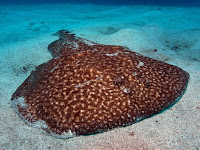A few weeks ago I was discussing with a
friend whether it is a good idea or not to recommend divers not to
wear gloves as a measure for the safeguard of the environment,
psychologically pushing on the potential risk of injuries caused my
marine life forms if touched bare hands.
This gave me the idea for a short research about potential hazards that can be caused by marine life
forms, focusing in particular on the Mediterranean area.
My purpose here is to show you how
limited is the risks for us scuba divers, if we follow two simple
rules:
- do not touch anything (also with the help of some buoyancy practice);
- respect marine life forms without harassing them.
In fact, statistically the high
majority of accidents and injuries from marine life forms are caused
by negligence or fault of scuba divers that provoke the animals!
Basically it is possible to identify 3
large categories of wounds that can be inflicted by marine life
forms:
- Traumatic injuries (e.g. bites and punctures);
- Stinging and envenomation, often in connection with bites or punctures. Envenomation is the process by which a venom or toxin is injected into another being and can be active (like in the case of jellyfish and some cone snails) or passive (scorpionfish, weever);
- Electrical shock: some marine animals can produce electricity through particular organs for hunting and self-defence purposes.
Let us now have a look ath the most "dangerous" animals of the Mediterranean Sea. As you can easily realize, the danger is more in our head than real!
 |
📸 (c) Dario Romeodario
@romeopix.com
|
Jellyfish: there are over 100 different species of jellyfish. The stinging
cells, called nematochysts, are located on the tentacles. Only in
some species the venom causes an adverse reaction in humans, with
effects that range form mild discomfort to extreme pain, but some
species can be deadly. The contact usually occurs accidentally, with
the diver not being aware of the presence of the jellyfish. Wearing a
protection suit drastically reduces the risk of being stung.
 |
📸 (c) Frédric Ducarme
|

Fireworms: fireworms can be found in the whole Mediterranean Sea, expecially around the Italian coasts. It is a slow creature, easy to be spotted crawling on the sea bottom, and is not considered a threat to humans unless touched. Its bristles can penetrate human skin, injecting a neurotoxin that produces intense irritation and a painful burning sensation around the area of contact. The sting can also lead to nausea and dizziness. This sensation lasts up to a few hours.
 |
| 📸 (c) Roberto Pillon |
 |
| 📸 (c) Wilfried Berns / Tiermotive.de |
Scorpionfish: are a family that includes many of the world's most venomous species. In the mediterranean sea the most common species is the red scorpionfish. Normally 30 cm long, its colour ranges from red to light pink, with dark coloured blotches on the body. It is a sedentary demersal fish that lives on rocky, sandy or muddy bottoms. The spines, located on the dorsal fin and next to the gills, cause a very painful sting that can lead to loss of consciousness.
 |
| 📸 (c) Steven van Tendeloo |
Moray eels: there are aproximatively 200 species of moray eels worldwide. Altough their apperance may look aggressive as they are often seen with their mouth open, this is just their way to breathe. Moray eels are night hunters and feed on small fishes, molluscs such as squids and cuttlefish and crabs. They are generally not a threat if not molested, so as a general reccomandation, avoid sticking your fingers in their open mouth! Their bite is not venomous but can lead to infection.
 |
| 📸 (c) Robert Patzner - Fishbase |
 |
| 📸 (c) Gargolla |
 |
| 📸 (c) Philippe Guillame |
Electric rays: the electric-shock producing organs are located on the wings and the fish stuns its prey by hovering over it. If a diver accidentally touches the electric organs can receive a similar shock that can be painful but very unlikely to cause loss of consciousness. Most incidents occur in limited visibility when a diver is crawling on a sandy bottom.
 |
| 📸 (c) Patrick Doll |
Triggerfish: triggerfish have a strong- jawed mouth with teeth adapted for crushing shells that can cause painful injuries. Males are territorial and fierce in guarding their territories, that extends in a cone from the nest toward the surface, so swimming upwards can put a diver further into the fish territory. A horizontal swim away from the nest site is best when confronted by an angry triggerfish.
 |
| 📸 (c) Doug Costa, NOAA / SBNMS |
Finally, just a few words about two invasive species that recently came to the Mediterranean area from the Red Sea through the Suez Channel (so called Lesseptian migration).
 |
| 📸 (c) S. Rothman |
 |
| 📸 (c) Alexander Vasenin |



No comments:
Post a Comment